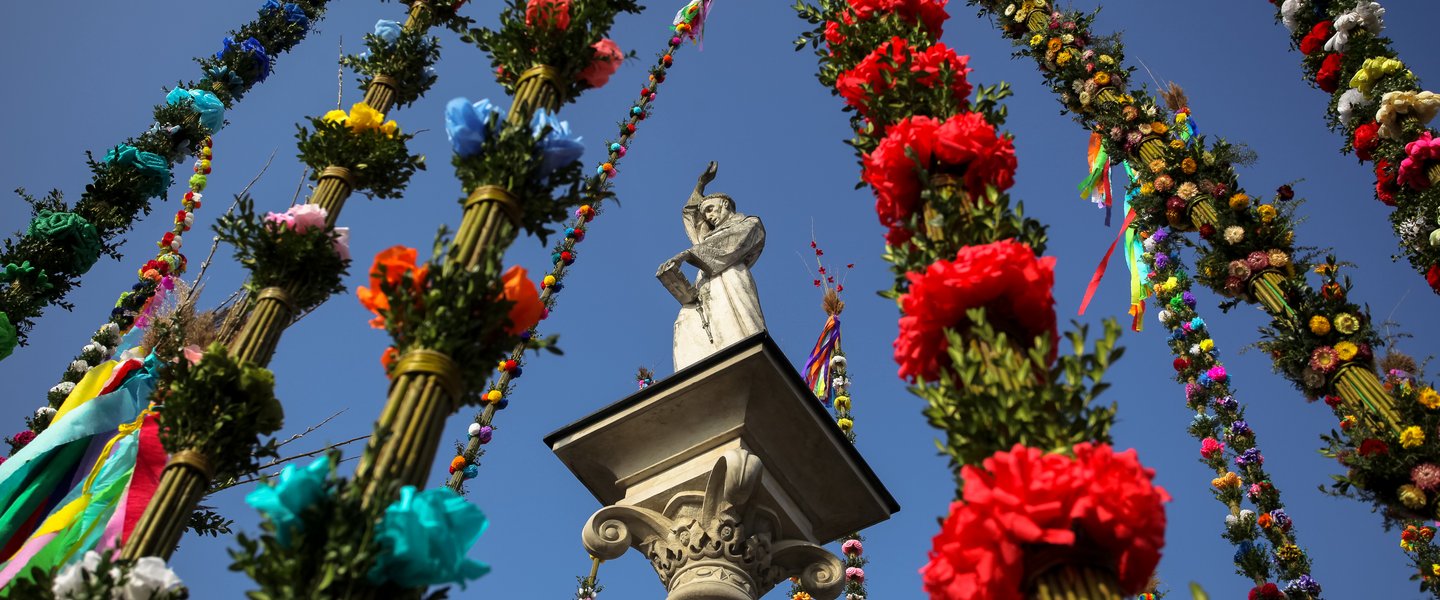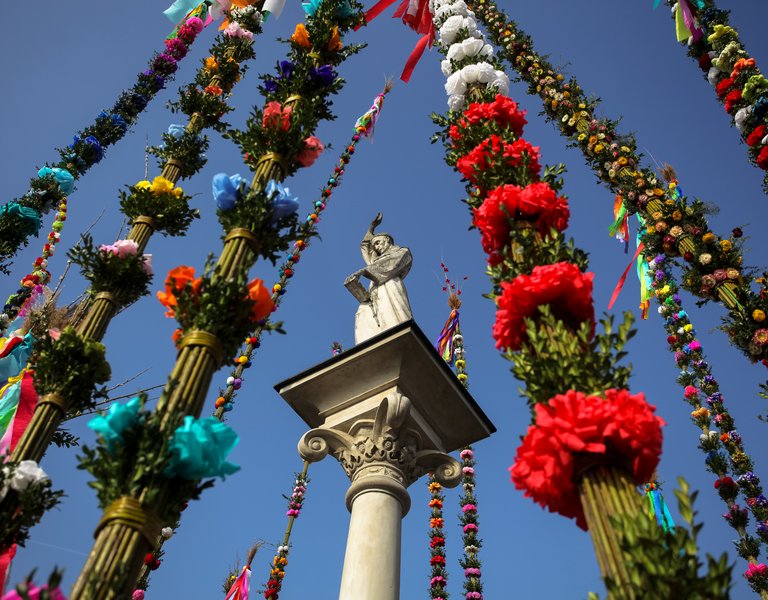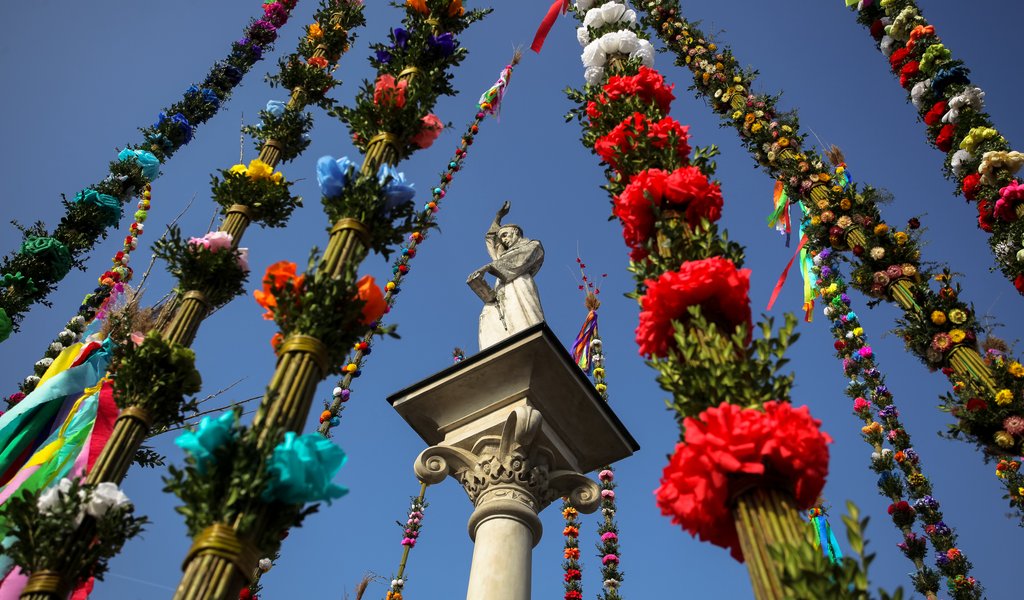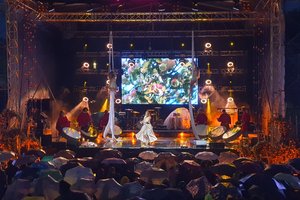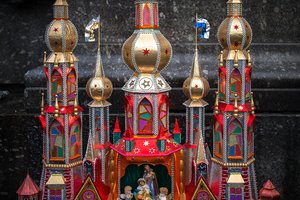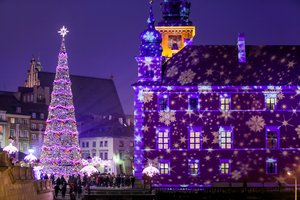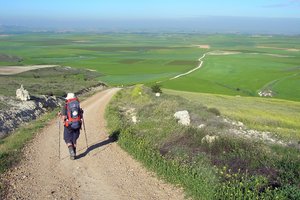On Polish Easter traditions
Easter traditions in Poland - read about Palm Sunday, Maundy Thursday, Christ’s tomb, Painted eggs and others.
Palm Sunday
Before Good Friday celebrations began in the Poland of olden days, willow rods, or raspberry or black currant bush branches were cut on Spy Wednesday and placed in jugs filled with water, to give them time to bloom. Then, on Palm Sunday, they were said to “blosme” or blossom. Just as children and adults today spray each other with water on Easter Monday (or Wet Monday), Palm Sunday used to be a time for fun and games, too. On Palm Sunday morning, people would run around homes, holding branches, laughing and waking each other up by tapping them gently with the switch, shouting: “The willow (palm) is whipping, I am not whipping, it’s the Good Day of the week, it’s Easter time in six days’ time!”
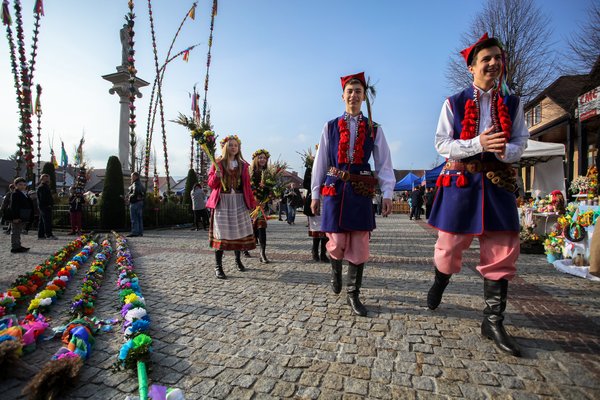 Everyone would then go to church to get their “palms” consecrated—the day was referred to as Palm or Willow Sunday. In some regions it was referred to as Blossom Sunday.
Everyone would then go to church to get their “palms” consecrated—the day was referred to as Palm or Willow Sunday. In some regions it was referred to as Blossom Sunday.
According to folk wisdom, consecrated willow rods and palms had special properties. The Renaissance poet Mikołaj Rej wrote, “Whosoever did not swallow the ‘down’, or Easter palm catkin on Blossom Sunday, he would not be delivered.” It was common knowledge that swallowing the catkin brought good health. Curiously, the tale turned full circle as the years passed; grandmothers started to warn youngsters against such fun, explaining that it was very dangerous and carried the threat of a small willow taking root in the stomach of any disbeliever.
Maundy Thursday
On every Good Thursday, a solemn ceremony took place at the Jasna Góra monastery, at the stroke of four in the morning. It was still dark when the fathers of the Pauline Order appeared in the corridors and then proceeded to the sacristy and opened the treasury. They then entered a small room at the back of the altar of the Most Holy Mother of the Saviour. They extracted a portrait of the Holy Mother and, genuflecting, placed it on a specially decorated table. They prayed and sang by candlelight. As they did so, the dress on the miraculous image of the Holy Virgin transformed. Before a new dress was affixed with wire, the portrait was covered with veils, lace, holy pictures, rosaries, and crucifixes owned by people who had requested that their belongings touch the holy relic.
During the last three days of the Holy Week, young swains dressed as soldiers kept guard at Christ’s tomb (a custom that is still observed today).
“In some regions, on Maundy Thursday (also called Thorn Thursday),” 19th-century historian and ethnographer Zygmunt Gloger wrote in his notes, “groups of boys would dress up as soldiers and— having fashioned a Judas out of straw, attired him in tattered black clothing, and placed a bag full of broken glass in his hand—would go to the Lauds on a dark morning, carrying Judas upon their shoulders. They would stand among the faithful under the choir, all dressed up, as if they were an army led by one. After the Lauds, Judas would be taken to the graveyard, struck with sticks and rods, and hacked to pieces with wooden scabbards—all to a backdrop of clamouring and laughter of the assembled folks. Judas would then be placed in a wheelbarrow for a trip and a repeat performance at the parsonage and manor would take place. From the manor, Judas would finally be taken to the inn where he would be drowned in a river or pond, or, once darkness fell, burnt at a stake on a hill beyond the village. In other regions, Judas would be taken on his rounds—after having been thrown off a tall tower—on Holy Saturday or Maundy Thursday. He would be cast out of the church with rattles, and always with a great din.”
Poles were clearly deeply convinced that treason should be properly stigmatised and punished.
Christ’s tomb
The entire Holy Week carried great importance and was sacred to the Poles: prayers were said twice as frequently, confessions were offered, intense labour and preparations for the Resurrection were constantly underway. Christ’s Tomb was lavishly decorated on Good Friday, with water effects and rich tapestries included as no expense was spared. Sometimes, all parishioners were responsible for decorating the Tomb but it could also happen that a single family provided the funds. In towns and cities, people would tour churches to visit the Tomb, as is still the custom today.
On Holy Saturday, tables were set with meat, pastry, and eggs from the early morning, all food to be consecrated—the custom was observed at manors as well as by wealthier townspeople. Hundreds of guests were invited to join their hosts at the consecrated table. “The lady of the house utilised all her talent to fashion her egg-cakes, her sponge cakes and her mazureks. A special book that she would usually rewrite in her own hand contained abundant recipes and secrets… one cannot imagine the trouble one had with huge sponge cakes, with placing these giants into and extracting them from the oven,” Gloger wrote. Nineteenth-century Polish writer Kraszewski remarked, “A lamb fashioned from sugar or butter would stand in the middle of the great table, adorned with a banner… a wild boar’s head with horseradish in the mouth would sit at one end, gazing upon a platter of eggs among garlands of smoked sausage and so on.”
Lambs have survived until today. Wild boar with horseradish in their mouths is a different story however. One can always dream… Other customs are still observed today, such as greeting hosts upon entering a home with “Christ is risen!” Some time ago, the salutation was delivered in Latin: “Resurexit sicut dixit, Alleluja!"
When the consecrated eggs had been passed out and warm wishes shared, the eggs were not eaten with cutlery but with ones fingers. And this is how it is still done today.
Painted eggs
Decorated eggs were already mentioned by mediaeval writer Wincenty Kadłubek in his Chronicle; he reproached his fellow countrymen, declaring that Poles had always been envious of their rulers and toyed with their lords “as if with painted eggs.” In all probability, he was referencing the old and traditional game of breaking painted eggs. Two people rolled (wealcanned) painted eggs towards each other. The point was to make one egg knock against the other. Whoever’s egg did not crack, won.
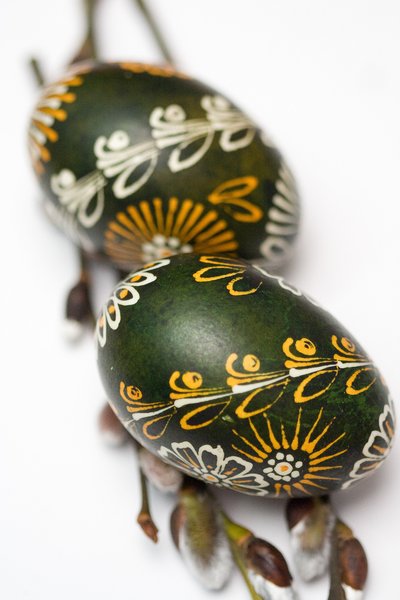 Nineteenth-century Polish writer and ethnographer Szczęsny Jastrzębowski wrote a marvellous piece about decorated eggs; he found mentions of painted eggs and the tradition of decorating them not only in works by 17th-centutry scholars, but even in writings by Juvenal, Ovid, and Pliny. According to Greek legend, Saint Magdalene introduced the custom of painting eggs. The theory was also confirmed in Polish writings. Jastrzębowski wrote, “An angel appeared before Mary Magdalene, afflicted at the Saviour’s empty Tomb, and spoke to her, ‘Do not weep, Mary, Christ is risen.’ She ran home in joy to find all the eggs she had left in her room painted red. Carrying them, she walked out of her home and saw the apostles. She began handing them the eggs, telling the news of the risen Lord. In the apostles’ palms, the eggs turned into birds as further proof that Christ’s death would morph into eternal life for humankind.”
Nineteenth-century Polish writer and ethnographer Szczęsny Jastrzębowski wrote a marvellous piece about decorated eggs; he found mentions of painted eggs and the tradition of decorating them not only in works by 17th-centutry scholars, but even in writings by Juvenal, Ovid, and Pliny. According to Greek legend, Saint Magdalene introduced the custom of painting eggs. The theory was also confirmed in Polish writings. Jastrzębowski wrote, “An angel appeared before Mary Magdalene, afflicted at the Saviour’s empty Tomb, and spoke to her, ‘Do not weep, Mary, Christ is risen.’ She ran home in joy to find all the eggs she had left in her room painted red. Carrying them, she walked out of her home and saw the apostles. She began handing them the eggs, telling the news of the risen Lord. In the apostles’ palms, the eggs turned into birds as further proof that Christ’s death would morph into eternal life for humankind.”
In the province of Siedlce it was said that rocks used to stone Saint Stephen to death had turned into painted eggs. According to another folk tale, when Christ was led to his death, a poor man carrying eggs to market in a basket entered the city. Upon seeing Jesus, the man placed his basket on the ground and helped the Saviour carry the cross. When he returned to collect his basket, “he found all eggs painted or dyed”.
Jastrzębowski further explains the origin of Easter egg names. They depended on the manner in which they were painted. Eggs dyed one colour (by boiling them or dipping them in dye) were called malowanki, kraszanki, or byczki (all derived from words meaning “to paint’). Once a dyed egg was adorned with any pattern, however, it rapidly changed its name to became a skrobanka or rysowanka (from the word meaning “to scratch”). Some preferred to decorate Easter eggs by affixing green stems of lilac or rush to the shell, and adding ornaments of colourful papers or rags. The most frequently used term for decorated eggs is pisanka. If a colourful pattern was obtained by covering an egg in wax before boiling it in dye, the result was referred to as pisanka, with an analogous verb used to describe the process. The pre-Easter decoration of eggs was entrusted to girls and young married women. It was a rare thing with boys. How did one do it? Pins, straws, broken needles or special tools (forked sticks with a piece of metal, a coin, or a shoelace clamp called pisaki, or kwaczyki) were used to apply wax in a proper fashion. The community of egg-decorating women produced true masters; they were capable of producing complicated and beautiful patterns, usually handed down in families from generation to generation. Some Polish villages boasted their own unique pisanka designs. “A folk ornament is never born suddenly”, Jastrzębowski wrote, “It is bred over a centuries-long process. From shapes single and simple, from a few mere parallel or crossed lines, a complex pattern was woven, rich in expression. Mothered by nature, it was attired by garments of imagination.”
Wet Monday
Last but not least, the śmigus-dyngus. In some provinces, our ancestors celebrated two traditions. The Mazovians used the term “dyngus” to describe the custom of a “buyout” or “roam toll”: boys would walk from house to house, collecting eggs and some of the consecrated food. The Mazurs called spraying animals with water “shmigus”. In other regions, the “dyngus” stood for the custom of spraying girls with water, and this was “an entertainment known across the land.” Eighteenth-century writer Andrzej Kitowicz recalled, “The water was poured in a variety of fashions: distinguished suitors, with intentions of not making the ceremony unpleasant to their ladies, squirted them lightly with rose or other fragrant water, moistening the hands, or the bosom, only, with a minuscule flacon. Others, with a penchant for gayer fun, used simple water, pouring it from pots, glasses, and other large receptacles onto the face or the entire body; once the company got truly merry, ladies, gentlemen, and courtiers alike, poured water on one another with any implements they could find..."
Following these fine examples, I wish you all the joys of Polish tradition at the end of the beautiful holy days of Resurrection. Hallelujah!
TOMASZ ŁYSIAK
Source: wSieci
14.04.2017
